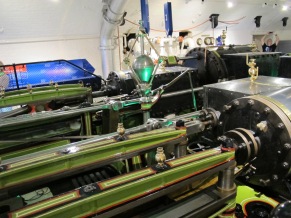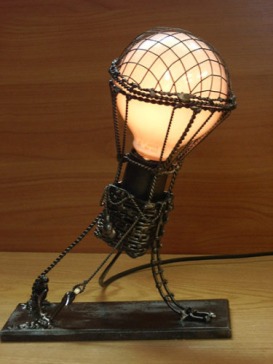The Science Museum, London

 This is definitely a must-see attraction for any Steampunk visiting London. The first exhibit you come to is called Energy Hall and features full-size steam engines and has interactive features that show you the physics of how they work and give the history of how they fit into the evolution of steam technology as a whole.
This is definitely a must-see attraction for any Steampunk visiting London. The first exhibit you come to is called Energy Hall and features full-size steam engines and has interactive features that show you the physics of how they work and give the history of how they fit into the evolution of steam technology as a whole.
But, the absolute best exhibit hall is Making the Modern world. It offers a veritable cornucopia of amazing inventions, including Charles Babbage’s Difference Engine No. 1 and a working model of a Victorian-era workshop run on a belt system.
Like the Museum of London, I would definitely recommend this as a great place to take people with mixed interests because the museum also has exhibits on the history of agriculture, real objects used in the early days of space travel and a “4D” cinema that has films on a wide range of topics.
The Tower Bridge Part 3: The Inner Workings

 My favorite part by far of visiting the Tower Bridge was venturing into the engine rooms below street level. The green and black coal-powered hydraulic engines reminded me of a giant mechanical grasshopper ready to spring, and made the whole exhibition worth the admission fee. One of the biggest surprises for me during Steam Tour was how colorful some of these old engines are! If you are a fan of engines and haven’t seem my post about the London Museum of Water and Steam don’t forget to take a look.
My favorite part by far of visiting the Tower Bridge was venturing into the engine rooms below street level. The green and black coal-powered hydraulic engines reminded me of a giant mechanical grasshopper ready to spring, and made the whole exhibition worth the admission fee. One of the biggest surprises for me during Steam Tour was how colorful some of these old engines are! If you are a fan of engines and haven’t seem my post about the London Museum of Water and Steam don’t forget to take a look.
How it works: “When it was built, Tower Bridge was the largest and most sophisticated bascule bridge ever completed (“bascule” comes from the French for “see-saw”). These bascules were operated by hydraulics, using steam to power the enormous pumping engines. The energy created was stored in six massive accumulators, as soon as power was required to lift the Bridge, it was always readily available. The accumulators fed the driving engines, which drove the bascules up and down. Despite the complexity of the system, the bascules only took about a minute to raise to their maximum angle of 86 degrees.” From the Tower Bridge website.
For more information and pictures from my visit to the Tower Bridge, check out Parts 1 and 2.
The Tower Bridge Part 1: The Outside

 Due to increased commercial activity along the Thames in the 19th century, the city of London needed to create bridges to allow access to both sides of the river without hindering the approach of tallships like the Cutty Sark (see above). To accomplish this goal, a committee was formed in 1877 to decide on a design for either a tunnel below the river or a bridge that allow traffic to cross over the water. More than 50 designs were considered before Sir Horace Jones’ hydraulic drawbridge was chosen in 1884, which took 10 years to complete. You can see some of the design submissions here.
Due to increased commercial activity along the Thames in the 19th century, the city of London needed to create bridges to allow access to both sides of the river without hindering the approach of tallships like the Cutty Sark (see above). To accomplish this goal, a committee was formed in 1877 to decide on a design for either a tunnel below the river or a bridge that allow traffic to cross over the water. More than 50 designs were considered before Sir Horace Jones’ hydraulic drawbridge was chosen in 1884, which took 10 years to complete. You can see some of the design submissions here.
Though the bridge has two towers built on foundations sunk deep in the river bottom, the name Tower Bridge comes from the nearby Tower of London. The bridge gets its strength from a steel skeleton, but the designers also used Portland stone across the facade to add a cosmetic touch.
The London Museum of Water and Steam

 This is my pick for the best place on my entire Steam Tour to take your littlest Steampunks. There are fun, hands-on exhibits about the water cycle and great info about the history of harnessing the Thames and combatting the Cholera outbreaks through London’s history. But the most exciting parts of the museum complex is room after room of real, working steam engines. They don’t run every engine every day, but I was lucky enough to visit on a bank holiday when they did run every engine for at least 15 minutes at some point during their open hours.
This is my pick for the best place on my entire Steam Tour to take your littlest Steampunks. There are fun, hands-on exhibits about the water cycle and great info about the history of harnessing the Thames and combatting the Cholera outbreaks through London’s history. But the most exciting parts of the museum complex is room after room of real, working steam engines. They don’t run every engine every day, but I was lucky enough to visit on a bank holiday when they did run every engine for at least 15 minutes at some point during their open hours.
In the courtyard there are some smaller engines as well as a station to make giant bubbles in the afternoon, so that is another plus for kids. There is also a replica of a Victorian-era workshop where all the machines run on the same belt system (the original workshop was destroyed during the Blitz) and they offer tours.
Steampunk Book Review: The Difference Engine

 A big part of my Steam Tour is finding out about the historical events and people who influenced the time period reflected in Steampunk books. I love the idea of alternate histories, and many times that is at the core of Steampunk novels, such as The Difference Engine by sci-fi greats William Gibson and Bruce Sterling.
A big part of my Steam Tour is finding out about the historical events and people who influenced the time period reflected in Steampunk books. I love the idea of alternate histories, and many times that is at the core of Steampunk novels, such as The Difference Engine by sci-fi greats William Gibson and Bruce Sterling.
If you are like me and you don’t have a good handle on the real history, I would recommend a quick glance at the wikipedia article about this book before you begin it. There is a great summary there of where and how the alternate history of the novel diverge from real events. I didn’t do this before I started reading and I spent a lot of the book wondering about fact and fiction.
In short, it tells the tale of the trajectory of the world if the computer age came in the 1800’s. The political structures all over the world are deeply effected by Charles Babbage’s completion of his mechanical computers (called Analytical Engines) in 1824, and there are numerous references to a fragmented United States (including a communist Manhattan) as well as historical figures such as Lord Byron, Ada Byron (the “queen of engines”), and Laurence Oliphant in different roles. The English politicial system has been completely dismantled and a meritocracy put up in place of hereditary lordships. The story is mostly told through the eyes of Edward Mallory, a “savant” who discovers the first huge dinosaur bones, giving him the nickname “Leviathan Mallory.”
There were a lot of things I really liked about this book. The descriptive language was excellent and Ned is a great character on whose coattails to ride through the adventure. I loved the shift in politics in response to technology and the parallels between then and now when it comes to the power of information. The authors clearly put a lot of thought into both logically and imaginatively extending the repercussions of the rise of computer technology long before we experienced it in our timeline.

Babbage later designed a simpler difference engine that was not built until the 20th century, on display at the Computer History Museum
On the whole, the story felt a bit fragmented because there are three distinct characters that get followed and the treatment is uneven. The first person you explore this world with is Sybil, and her story comes to an abrupt halt right as it gets really interesting. Then Mallory comes onto the scene and his story is great, but I couldn’t help but wonder where Sybil had gone to. Mallory’s tale comes to a head and he gets what he wants, but he is not actually the agent of change so even though there is a stand-off and big ‘splosions (whoo-hoo!) it felt sort of anticlimactic. Lastly, we trail Mallory’s one-time ally Laurence Oliphant for a little while on his political espionage. Each section was full of wonderful prose, but as a full story it ended up feeling kind of jerky and a bit too long.
That being said, I think it is definitely worth a read for the wonderful writing and imagination of the authors.
Have you read this book? What did you think?
Mechanical Marvels at the National Museum of Scotland

The Mister and I stumbled upon this amazing museum totally by mistake. We had just escaped the crowd on the Royal Mile after picking up our tickets for Fringe and were looking for a quieter place to look at the map. We soon found ourselves on the stone steps outside the National Museum of Scotland with a few hours to kill before our first show. A few hours wasn’t nearly enough!
The first visit was spent mostly in the ancient history section, but we went back a second day to check out the rest of the historical and industrial arts exhibits. If you are a fan of steam engines, elaborate clockwork, intricate model ships and all manner of shiny things, don’t miss this stop if you find yourself in Edinburgh. The museum recently underwent a massive renovation, but the largest gallery dates to the Victorian era and calls to mind the pictures I have seen of the Crystal Palace.
I hope you enjoy the gallery of photos below. (Click on any picture to see a them in a different view).
Have you ever visited this museum? Did you have a favorite part?
Leave a comment below!































































































































